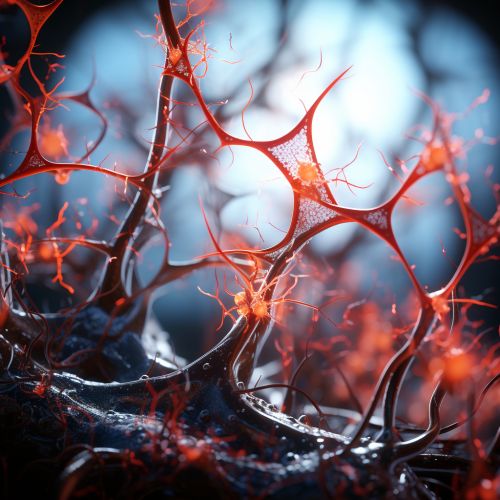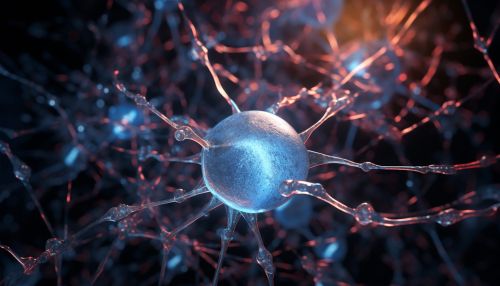Neuron
Structure and Function of Neurons
Neurons, also known as nerve cells, are the fundamental units of the nervous system, the complex network that coordinates actions and sensory information by transmitting signals to and from different parts of an organism's body. They are specialized cells that transmit electrical and chemical signals, serving as the basic building blocks of the nervous system.


Anatomy of a Neuron
A typical neuron consists of a cell body, dendrites, and an axon. The cell body, also known as the soma, contains the nucleus of the cell and other organelles, and is responsible for maintaining the life of the cell. Dendrites are branch-like structures that extend from the cell body, receiving signals from other neurons and transmitting them towards the cell body. The axon, on the other hand, is a long, slender projection that conducts electrical impulses away from the neuron's cell body.
Cell Body
The cell body, or soma, is the largest part of a neuron. It contains the neuron's nucleus (with DNA and typical nuclear organelles). The cell body produces proteins needed for the neuron to function and survive. It also contains specialized structures, called mitochondria, that provide the energy the neuron needs to function.
Dendrites
Dendrites are branch-like extensions of the neuron that receive signals from other neurons and transmit them towards the cell body. They are covered in synapses, which are junctions where neurons communicate with each other through neurotransmitters. The dendrites' structure maximizes the contact points between neurons, facilitating complex neural communication networks.
Axon
The axon is a long, slender projection of the neuron that conducts electrical impulses away from the neuron's cell body towards other neurons or effector cells. The axon is insulated by a myelin sheath, a fatty layer that speeds up the transmission of electrical signals along the axon. At the end of the axon, the axon terminals contain small sacs called synaptic vesicles that store neurotransmitters, the chemical messengers of the nervous system.
Types of Neurons
There are three main types of neurons: sensory neurons, motor neurons, and interneurons. Sensory neurons transmit signals from peripheral sensory organs (such as the skin, eyes, and nose) to the central nervous system. Motor neurons transmit signals from the central nervous system to the peripheral effector organs (such as muscles and glands). Interneurons, or association neurons, provide connections between sensory and motor neurons, as well as between themselves.
Neuronal Communication
Neurons communicate with each other through a process known as synaptic transmission. This involves the release of neurotransmitters from the axon terminal of a presynaptic neuron into the synaptic cleft, the tiny gap between neurons. These neurotransmitters bind to receptors on the postsynaptic neuron, triggering a response in this neuron.
Neurons in the Nervous System
Neurons form the core of the nervous system, which includes the brain, spinal cord, and peripheral nerves. They are responsible for interpreting sensory information, generating motor commands, and performing complex cognitive functions.
Neurons in the Brain
The brain is composed of billions of neurons, interconnected in networks that form the basis of neural "circuits." Neurons in the brain are categorized into several types based on their function and structure, including pyramidal neurons, Purkinje cells, and granule cells, among others.
Neurons in the Spinal Cord
The spinal cord contains both sensory and motor neurons. Sensory neurons transmit signals from peripheral organs to the brain, while motor neurons transmit signals from the brain to the peripheral organs. The spinal cord also contains interneurons, which connect various neurons within the spinal cord.
Peripheral Nervous System
The peripheral nervous system (PNS) is composed of all the neurons that exist outside the brain and spinal cord. The PNS includes the somatic nervous system, which controls voluntary muscle movements and reflex arcs, and the autonomic nervous system, which controls involuntary functions such as heart rate and digestion.
Disorders Affecting Neurons
Neurons can be affected by a variety of disorders, including neurodegenerative diseases, injuries, and tumors. Neurodegenerative diseases, such as Alzheimer's disease, Parkinson's disease, and amyotrophic lateral sclerosis (ALS), involve the progressive loss of structure or function of neurons. Injuries, such as spinal cord injuries, can cause neurons to die, resulting in loss of function. Tumors can also affect neurons by causing uncontrolled cell growth in the nervous system.
